曼昆微观经济学 课后答案
- 格式:docx
- 大小:14.67 KB
- 文档页数:11
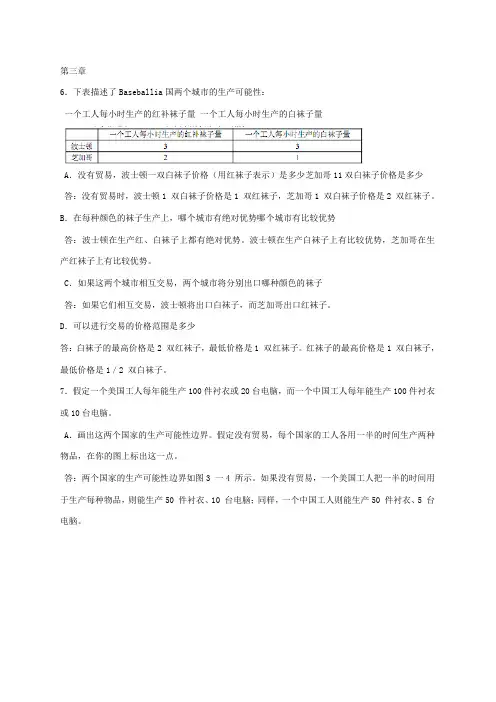
第三章6.下表描述了Baseballia国两个城市的生产可能性:一个工人每小时生产的红补袜子量一个工人每小时生产的白袜子量A.没有贸易,波士顿一双白袜子价格(用红袜子表示)是多少芝加哥11双白袜子价格是多少答:没有贸易时,波士顿1 双白袜子价格是1 双红袜子,芝加哥1 双白袜子价格是2 双红袜子。
B.在每种颜色的袜子生产上,哪个城市有绝对优势哪个城市有比较优势答:波士顿在生产红、白袜子上都有绝对优势。
波士顿在生产白袜子上有比较优势,芝加哥在生产红袜子上有比较优势。
C.如果这两个城市相互交易,两个城市将分别出口哪种颜色的袜子答:如果它们相互交易,波士顿将出口白袜子,而芝加哥出口红袜子。
D.可以进行交易的价格范围是多少答:白袜子的最高价格是2 双红袜子,最低价格是1 双红袜子。
红袜子的最高价格是1 双白袜子,最低价格是1/2 双白袜子。
7.假定一个美国工人每年能生产100件衬衣或20台电脑,而一个中国工人每年能生产100件衬衣或10台电脑。
A.画出这两个国家的生产可能性边界。
假定没有贸易,每个国家的工人各用一半的时间生产两种物品,在你的图上标出这一点。
答:两个国家的生产可能性边界如图3 一4 所示。
如果没有贸易,一个美国工人把一半的时间用于生产每种物品,则能生产50 件衬衣、10 台电脑;同样,一个中国工人则能生产50 件衬衣、5 台电脑。
图3 一4 生产可能性边界B.如果这两个国家进行贸易,哪个国家将出口衬衣举出一个具体的数字例子,并在你的图上标出。
哪一个国家将从贸易中获益解释原因。
答:中国将出口衬衣。
对美国而言,生产一台电脑的机会成本是5 件衬衣,而生产一件衬衣的机会成本为1/5 台电脑。
对中国而言,生产一台电脑的机会成本是10 件衬衣,而生产一件衬衣的机会成本为1/10 台电脑。
因此,美国在生产电脑上有比较优势,中国在生产衬衣上有比较优势,所以中国将出口衬衣。
衬衣的价格在1/5 到1/10 台电脑之间。
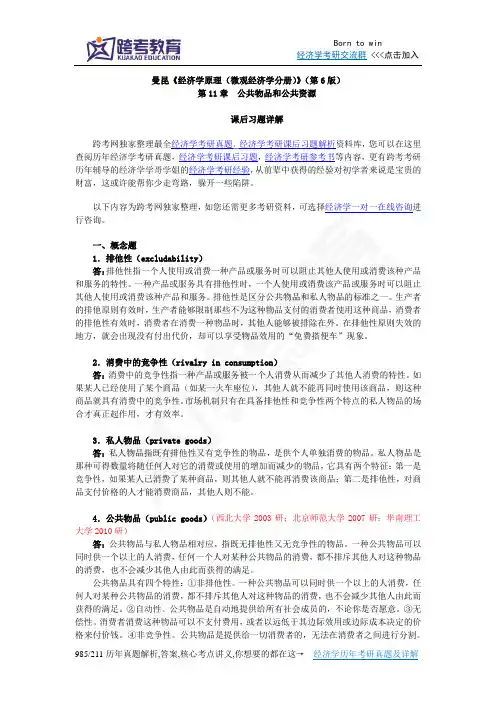
曼昆《经济学原理(微观经济学分册)》(第6版)第11章公共物品和公共资源课后习题详解跨考网独家整理最全经济学考研真题,经济学考研课后习题解析资料库,您可以在这里查阅历年经济学考研真题,经济学考研课后习题,经济学考研参考书等内容,更有跨考考研历年辅导的经济学学哥学姐的经济学考研经验,从前辈中获得的经验对初学者来说是宝贵的财富,这或许能帮你少走弯路,躲开一些陷阱。
以下内容为跨考网独家整理,如您还需更多考研资料,可选择经济学一对一在线咨询进行咨询。
一、概念题1.排他性(excludability)答:排他性指一个人使用或消费一种产品或服务时可以阻止其他人使用或消费该种产品和服务的特性。
一种产品或服务具有排他性时,一个人使用或消费该产品或服务时可以阻止其他人使用或消费该种产品和服务。
排他性是区分公共物品和私人物品的标准之一。
生产者的排他原则有效时,生产者能够限制那些不为这种物品支付的消费者使用这种商品,消费者的排他性有效时,消费者在消费一种物品时,其他人能够被排除在外。
在排他性原则失效的地方,就会出现没有付出代价,却可以享受物品效用的“免费搭便车”现象。
2.消费中的竞争性(rivalry in consumption)答:消费中的竞争性指一种产品或服务被一个人消费从而减少了其他人消费的特性。
如果某人已经使用了某个商品(如某一火车座位),其他人就不能再同时使用该商品,则这种商品就具有消费中的竞争性。
市场机制只有在具备排他性和竞争性两个特点的私人物品的场合才真正起作用,才有效率。
3.私人物品(private goods)答:私人物品指既有排他性又有竞争性的物品,是供个人单独消费的物品。
私人物品是那种可得数量将随任何人对它的消费或使用的增加而减少的物品,它具有两个特征:第一是竞争性,如果某人已消费了某种商品,则其他人就不能再消费该商品;第二是排他性,对商品支付价格的人才能消费商品,其他人则不能。
4.公共物品(public goods)(西北大学2003研;北京师范大学2007研;华南理工大学2010研)答:公共物品与私人物品相对应,指既无排他性又无竞争性的物品。
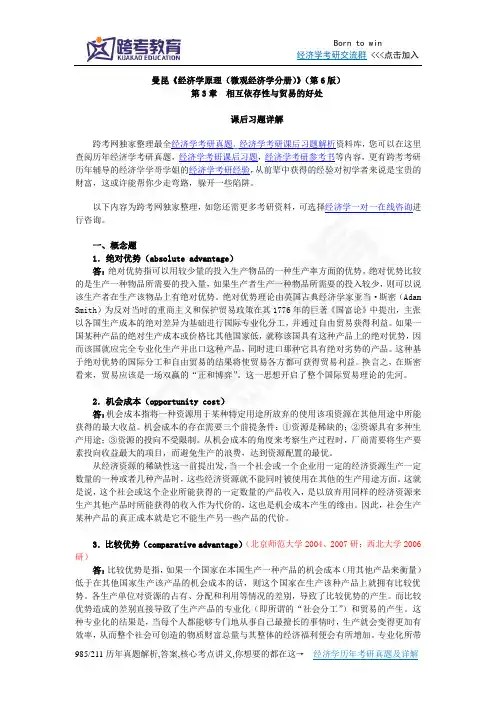
曼昆《经济学原理(微观经济学分册)》(第6版)第3章相互依存性与贸易的好处课后习题详解跨考网独家整理最全经济学考研真题,经济学考研课后习题解析资料库,您可以在这里查阅历年经济学考研真题,经济学考研课后习题,经济学考研参考书等内容,更有跨考考研历年辅导的经济学学哥学姐的经济学考研经验,从前辈中获得的经验对初学者来说是宝贵的财富,这或许能帮你少走弯路,躲开一些陷阱。
以下内容为跨考网独家整理,如您还需更多考研资料,可选择经济学一对一在线咨询进行咨询。
一、概念题1.绝对优势(absolute advantage)答:绝对优势指可以用较少量的投入生产物品的一种生产率方面的优势。
绝对优势比较的是生产一种物品所需要的投入量,如果生产者生产一种物品所需要的投入较少,则可以说该生产者在生产该物品上有绝对优势。
绝对优势理论由英国古典经济学家亚当·斯密(Adam Smith)为反对当时的重商主义和保护贸易政策在其1776年的巨著《国富论》中提出,主张以各国生产成本的绝对差异为基础进行国际专业化分工,并通过自由贸易获得利益。
如果一国某种产品的绝对生产成本或价格比其他国家低,就称该国具有这种产品上的绝对优势,因而该国就应完全专业化生产并出口这种产品,同时进口那种它具有绝对劣势的产品。
这种基于绝对优势的国际分工和自由贸易的结果将使贸易各方都可获得贸易利益。
换言之,在斯密看来,贸易应该是一场双赢的“正和博弈”。
这一思想开启了整个国际贸易理论的先河。
2.机会成本(opportunity cost)答:机会成本指将一种资源用于某种特定用途所放弃的使用该项资源在其他用途中所能获得的最大收益。
机会成本的存在需要三个前提条件:①资源是稀缺的;②资源具有多种生产用途;③资源的投向不受限制。
从机会成本的角度来考察生产过程时,厂商需要将生产要素投向收益最大的项目,而避免生产的浪费,达到资源配置的最优。
从经济资源的稀缺性这一前提出发,当一个社会或一个企业用一定的经济资源生产一定数量的一种或者几种产品时,这些经济资源就不能同时被使用在其他的生产用途方面。
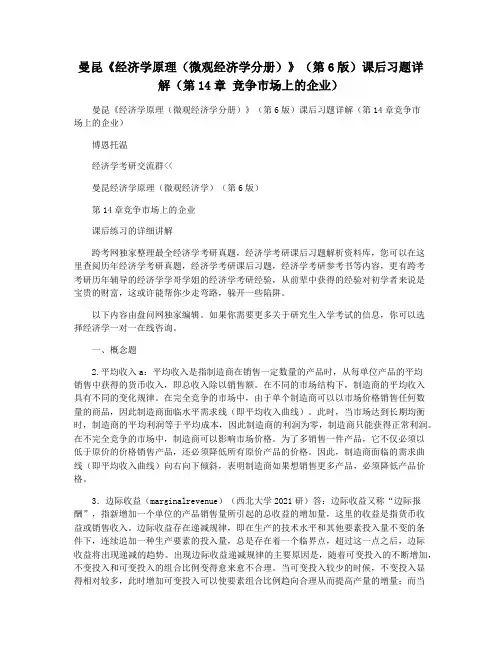
曼昆《经济学原理(微观经济学分册)》(第6版)课后习题详解(第14章竞争市场上的企业)曼昆《经济学原理(微观经济学分册)》(第6版)课后习题详解(第14章竞争市场上的企业)博恩托温经济学考研交流群<<曼昆经济学原理(微观经济学)(第6版)第14章竞争市场上的企业课后练习的详细讲解跨考网独家整理最全经济学考研真题,经济学考研课后习题解析资料库,您可以在这里查阅历年经济学考研真题,经济学考研课后习题,经济学考研参考书等内容,更有跨考考研历年辅导的经济学学哥学姐的经济学考研经验,从前辈中获得的经验对初学者来说是宝贵的财富,这或许能帮你少走弯路,躲开一些陷阱。
以下内容由盘问网独家编辑。
如果你需要更多关于研究生入学考试的信息,你可以选择经济学一对一在线咨询。
一、概念题2.平均收入a:平均收入是指制造商在销售一定数量的产品时,从每单位产品的平均销售中获得的货币收入,即总收入除以销售额。
在不同的市场结构下,制造商的平均收入具有不同的变化规律。
在完全竞争的市场中,由于单个制造商可以以市场价格销售任何数量的商品,因此制造商面临水平需求线(即平均收入曲线)。
此时,当市场达到长期均衡时,制造商的平均利润等于平均成本,因此制造商的利润为零,制造商只能获得正常利润。
在不完全竞争的市场中,制造商可以影响市场价格。
为了多销售一件产品,它不仅必须以低于原价的价格销售产品,还必须降低所有原价产品的价格。
因此,制造商面临的需求曲线(即平均收入曲线)向右向下倾斜,表明制造商如果想销售更多产品,必须降低产品价格。
3.边际收益(marginalrevenue)(西北大学2021研)答:边际收益又称“边际报酬”,指新增加一个单位的产品销售量所引起的总收益的增加量,这里的收益是指货币收益或销售收入。
边际收益存在递减规律,即在生产的技术水平和其他要素投入量不变的条件下,连续追加一种生产要素的投入量,总是存在着一个临界点,超过这一点之后,边际收益将出现递减的趋势。
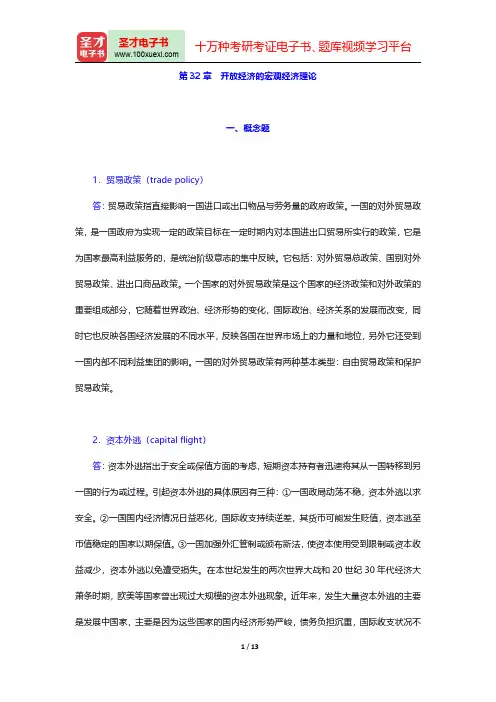
第32章开放经济的宏观经济理论一、概念题1.贸易政策(trade policy)答:贸易政策指直接影响一国进口或出口物品与劳务量的政府政策。
一国的对外贸易政策,是一国政府为实现一定的政策目标在一定时期内对本国进出口贸易所实行的政策,它是为国家最高利益服务的,是统治阶级意志的集中反映。
它包括:对外贸易总政策、国别对外贸易政策、进出口商品政策。
一个国家的对外贸易政策是这个国家的经济政策和对外政策的重要组成部分,它随着世界政治、经济形势的变化,国际政治、经济关系的发展而改变,同时它也反映各国经济发展的不同水平,反映各国在世界市场上的力量和地位,另外它还受到一国内部不同利益集团的影响。
一国的对外贸易政策有两种基本类型:自由贸易政策和保护贸易政策。
2.资本外逃(capital flight)答:资本外逃指出于安全或保值方面的考虑,短期资本持有者迅速将其从一国转移到另一国的行为或过程。
引起资本外逃的具体原因有三种:①一国政局动荡不稳,资本外逃以求安全。
②一国国内经济情况日益恶化,国际收支持续逆差,其货币可能发生贬值,资本逃至币值稳定的国家以期保值。
③一国加强外汇管制或颁布新法,使资本使用受到限制或资本收益减少,资本外逃以免遭受损失。
在本世纪发生的两次世界大战和20世纪30年代经济大萧条时期,欧美等国家曾出现过大规模的资本外逃现象。
近年来,发生大量资本外逃的主要是发展中国家,主要是因为这些国家的国内经济形势严峻,债务负担沉重,国际收支状况不断恶化以及国内政局动荡。
资本外逃对于一国的经济发展和国际收支稳定有着十分不利的影响。
它将降低该国的国内储蓄水平,从而造成投资下降和生产萎缩;它将加剧国际收支逆差,从而引起外汇储备的减少和国际清偿能力的恶化;大量资本外逃时,如果一国试图维持一定的生产和消费水平,势必引起外债负担的迅速积累。
因此,防止资本外逃是一国宏观经济政策的一项重要任务。
二、复习题1.说明可贷资金市场与外汇市场的供给与需求。
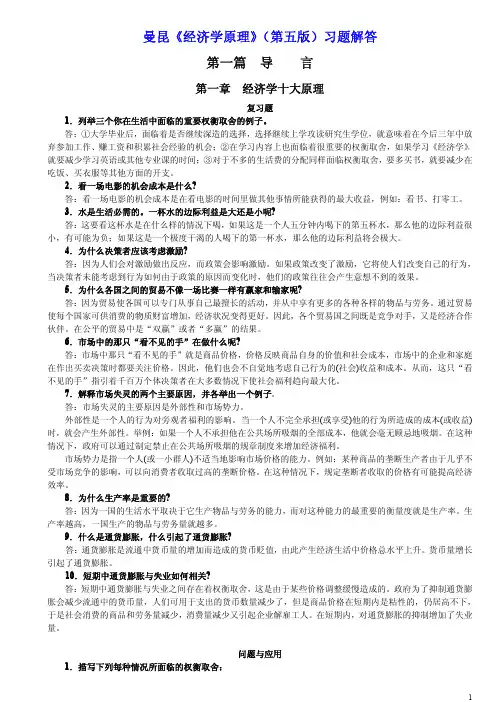
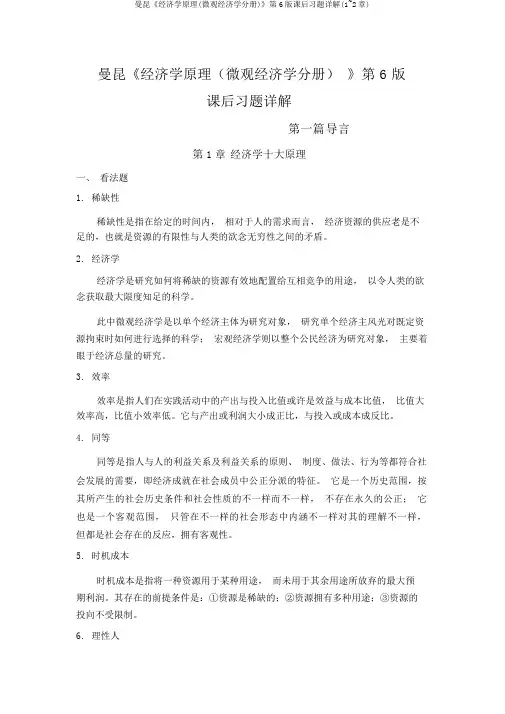
曼昆《经济学原理(微观经济学分册)》第 6 版课后习题详解第一篇导言第1章经济学十大原理一、看法题1.稀缺性稀缺性是指在给定的时间内,相对于人的需求而言,经济资源的供应老是不足的,也就是资源的有限性与人类的欲念无穷性之间的矛盾。
2.经济学经济学是研究如何将稀缺的资源有效地配置给互相竞争的用途,以令人类的欲念获取最大限度知足的科学。
此中微观经济学是以单个经济主体为研究对象,研究单个经济主风光对既定资源拘束时如何进行选择的科学;宏观经济学则以整个公民经济为研究对象,主要着眼于经济总量的研究。
3.效率效率是指人们在实践活动中的产出与投入比值或许是效益与成本比值,比值大效率高,比值小效率低。
它与产出或利润大小成正比,与投入或成本成反比。
4.同等同等是指人与人的利益关系及利益关系的原则、制度、做法、行为等都符合社会发展的需要,即经济成就在社会成员中公正分派的特征。
它是一个历史范围,按其所产生的社会历史条件和社会性质的不一样而不一样,不存在永久的公正;它也是一个客观范围,只管在不一样的社会形态中内涵不一样对其的理解不一样,但都是社会存在的反应,拥有客观性。
5.时机成本时机成本是指将一种资源用于某种用途,而未用于其余用途所放弃的最大预期利润。
其存在的前提条件是:①资源是稀缺的;②资源拥有多种用途;③资源的投向不受限制。
6.理性人理性人是指系统而有目的地尽最大努力去实现其目标的人,是经济研究中所假定的、在必定条件下拥有典型理性行为的经济活动主体。
7.边沿改动边沿改动是指对行动计划的细小增量调整。
8.激励激励是指惹起一个人做出某种行为的某种东西。
9.市场经济市场经济是指由家庭和公司在市场上的互相交易决定资源配置的经济,而资源配置本质上就是决定社会生产什么、生产多少、如何生产以及为谁生产的过程。
10.产权产权是指个人拥有并控制稀缺资源的能力,也能够理解为人们对其所交易东西的所有权,即人们在交易活动中使自己或别人在经济利益上得益或受损的权利。
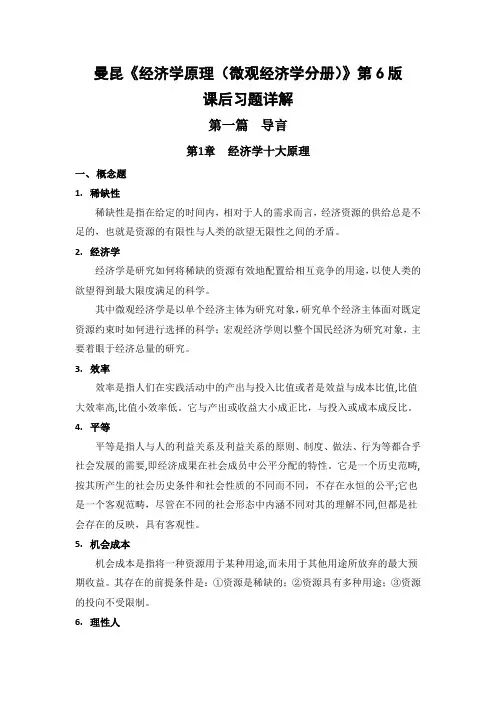
曼昆《经济学原理(微观经济学分册)》第6版课后习题详解第一篇导言第1章经济学十大原理一、概念题1.稀缺性稀缺性是指在给定的时间内,相对于人的需求而言,经济资源的供给总是不足的,也就是资源的有限性与人类的欲望无限性之间的矛盾。
2.经济学经济学是研究如何将稀缺的资源有效地配置给相互竞争的用途,以使人类的欲望得到最大限度满足的科学。
其中微观经济学是以单个经济主体为研究对象,研究单个经济主体面对既定资源约束时如何进行选择的科学;宏观经济学则以整个国民经济为研究对象,主要着眼于经济总量的研究。
3.效率效率是指人们在实践活动中的产出与投入比值或者是效益与成本比值,比值大效率高,比值小效率低。
它与产出或收益大小成正比,与投入或成本成反比。
4.平等平等是指人与人的利益关系及利益关系的原则、制度、做法、行为等都合乎社会发展的需要,即经济成果在社会成员中公平分配的特性。
它是一个历史范畴,按其所产生的社会历史条件和社会性质的不同而不同,不存在永恒的公平;它也是一个客观范畴,尽管在不同的社会形态中内涵不同对其的理解不同,但都是社会存在的反映,具有客观性。
5.机会成本机会成本是指将一种资源用于某种用途,而未用于其他用途所放弃的最大预期收益。
其存在的前提条件是:①资源是稀缺的;②资源具有多种用途;③资源的投向不受限制。
6.理性人理性人是指系统而有目的地尽最大努力去实现其目标的人,是经济研究中所假设的、在一定条件下具有典型理性行为的经济活动主体.7.边际变动边际变动是指对行动计划的微小增量调整。
8.激励激励是指引起一个人做出某种行为的某种东西。
9.市场经济市场经济是指由家庭和企业在市场上的相互交易决定资源配置的经济,而资源配置实际上就是决定社会生产什么、生产多少、如何生产以及为谁生产的过程。
10.产权产权是指个人拥有并控制稀缺资源的能力,也可以理解为人们对其所交易东西的所有权,即人们在交易活动中使自己或他人在经济利益上受益或受损的权力。
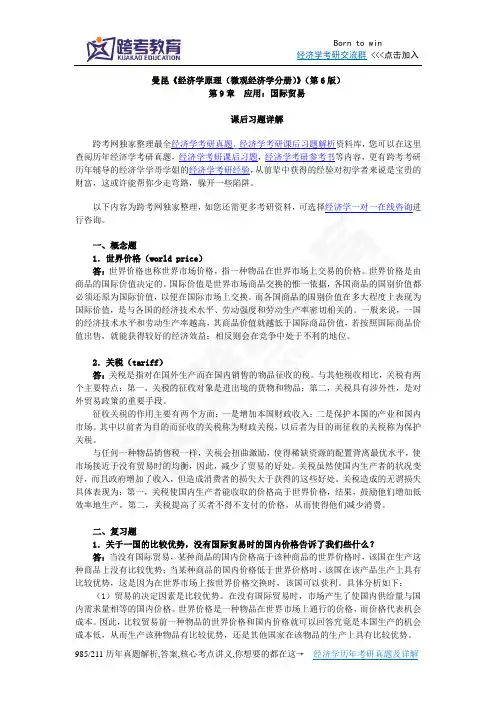
曼昆《经济学原理(微观经济学分册)》(第6版)第9章应用:国际贸易课后习题详解跨考网独家整理最全经济学考研真题,经济学考研课后习题解析资料库,您可以在这里查阅历年经济学考研真题,经济学考研课后习题,经济学考研参考书等内容,更有跨考考研历年辅导的经济学学哥学姐的经济学考研经验,从前辈中获得的经验对初学者来说是宝贵的财富,这或许能帮你少走弯路,躲开一些陷阱。
以下内容为跨考网独家整理,如您还需更多考研资料,可选择经济学一对一在线咨询进行咨询。
一、概念题1.世界价格(world price)答:世界价格也称世界市场价格,指一种物品在世界市场上交易的价格。
世界价格是由商品的国际价值决定的。
国际价值是世界市场商品交换的惟一依据,各国商品的国别价值都必须还原为国际价值,以便在国际市场上交换。
而各国商品的国别价值在多大程度上表现为国际价值,是与各国的经济技术水平、劳动强度和劳动生产率密切相关的。
一般来说,一国的经济技术水平和劳动生产率越高,其商品价值就越低于国际商品价值,若按照国际商品价值出售,就能获得较好的经济效益;相反则会在竞争中处于不利的地位。
2.关税(tariff)答:关税是指对在国外生产而在国内销售的物品征收的税。
与其他税收相比,关税有两个主要特点:第一,关税的征收对象是进出境的货物和物品;第二,关税具有涉外性,是对外贸易政策的重要手段。
征收关税的作用主要有两个方面:一是增加本国财政收入;二是保护本国的产业和国内市场。
其中以前者为目的而征收的关税称为财政关税,以后者为目的而征收的关税称为保护关税。
与任何一种物品销售税一样,关税会扭曲激励,使得稀缺资源的配置背离最优水平,使市场接近于没有贸易时的均衡,因此,减少了贸易的好处。
关税虽然使国内生产者的状况变好,而且政府增加了收入,但造成消费者的损失大于获得的这些好处。
关税造成的无谓损失具体表现为:第一,关税使国内生产者能收取的价格高于世界价格,结果,鼓励他们增加低效率地生产。
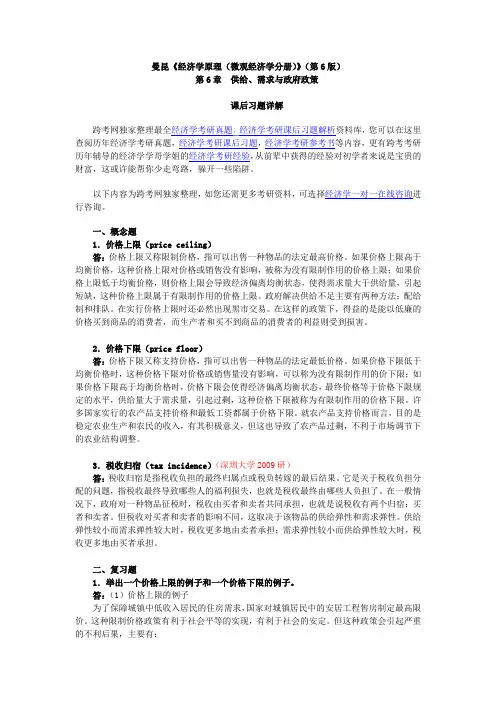
曼昆《经济学原理(微观经济学分册)》(第6版)第6章供给、需求与政府政策课后习题详解跨考网独家整理最全经济学考研真题,经济学考研课后习题解析资料库,您可以在这里查阅历年经济学考研真题,经济学考研课后习题,经济学考研参考书等内容,更有跨考考研历年辅导的经济学学哥学姐的经济学考研经验,从前辈中获得的经验对初学者来说是宝贵的财富,这或许能帮你少走弯路,躲开一些陷阱。
以下内容为跨考网独家整理,如您还需更多考研资料,可选择经济学一对一在线咨询进行咨询。
一、概念题1.价格上限(price ceiling)答:价格上限又称限制价格,指可以出售一种物品的法定最高价格。
如果价格上限高于均衡价格,这种价格上限对价格或销售没有影响,被称为没有限制作用的价格上限;如果价格上限低于均衡价格,则价格上限会导致经济偏离均衡状态,使得需求量大于供给量,引起短缺,这种价格上限属于有限制作用的价格上限。
政府解决供给不足主要有两种方法:配给制和排队。
在实行价格上限时还必然出现黑市交易。
在这样的政策下,得益的是能以低廉的价格买到商品的消费者,而生产者和买不到商品的消费者的利益则受到损害。
2.价格下限(price floor)答:价格下限又称支持价格,指可以出售一种物品的法定最低价格。
如果价格下限低于均衡价格时,这种价格下限对价格或销售量没有影响,可以称为没有限制作用的价下限;如果价格下限高于均衡价格时,价格下限会使得经济偏离均衡状态,最终价格等于价格下限规定的水平,供给量大于需求量,引起过剩,这种价格下限被称为有限制作用的价格下限。
许多国家实行的农产品支持价格和最低工资都属于价格下限。
就农产品支持价格而言,目的是稳定农业生产和农民的收入,有其积极意义,但这也导致了农产品过剩,不利于市场调节下的农业结构调整。
3.税收归宿(tax incidence)(深圳大学2009研)答:税收归宿是指税收负担的最终归属点或税负转嫁的最后结果。
它是关于税收负担分配的问题,指税收最终导致哪些人的福利损失,也就是税收最终由哪些人负担了。
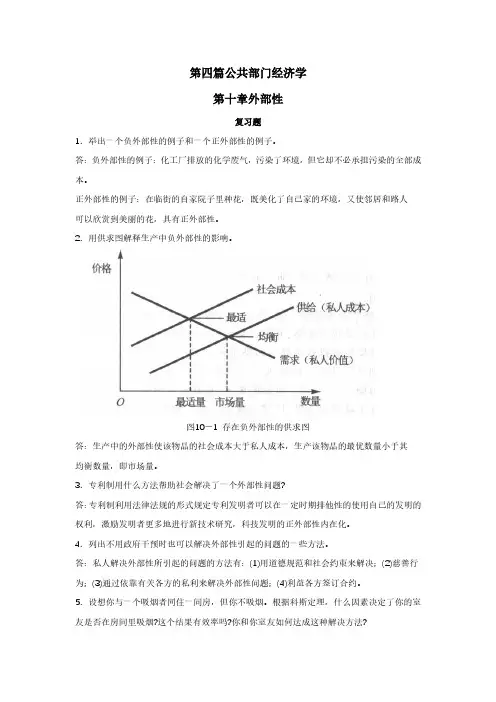
Born to win 经济学考研交流群 <<<点击加入985/211历年真题解析,答案,核心考点讲义,你想要的都在这→ 经济学历年考研真题及详解曼昆《经济学原理(微观经济学分册)》(第6版)第14章 竞争市场上的企业课后习题详解跨考网独家整理最全经济学考研真题,经济学考研课后习题解析资料库,您可以在这里查阅历年经济学考研真题,经济学考研课后习题,经济学考研参考书等内容,更有跨考考研历年辅导的经济学学哥学姐的经济学考研经验,从前辈中获得的经验对初学者来说是宝贵的财富,这或许能帮你少走弯路,躲开一些陷阱。
以下内容为跨考网独家整理,如您还需更多考研资料,可选择经济学一对一在线咨询进行咨询。
一、概念题1.竞争市场(competitive market )(山东大学2007研)答:竞争市场指有许多买者和卖者,以至于每一个人对市场价格的影响都微不足道的市场。
竞争市场一般指完全竞争市场。
完全竞争又称为纯粹竞争,是指不存在任何阻碍和干扰因素的市场情况,亦即没有任何垄断因素的市场结构。
完全竞争市场需要具备以下四个条件:①市场上有大量的买者和卖者;②市场上每一个厂商提供的商品都是同质的;③所有的资源具有完全的流动性;④信息是完全的。
2.平均收益(average revenue )答:平均收益指厂商在出售一定数量的产品时,平均出售每一单位的产品所获得的货币收入,即总收益除以销售量。
在不同的市场结构中,厂商的平均收益具有不同的变化规律。
在完全竞争市场中,由于单个厂商可以在市场价格下出售任何数量的商品,厂商面临一条水平的需求线(即平均收益曲线)。
这时,当市场达到长期均衡时,厂商的平均收益与平均成本相等,所以厂商的利润为零,厂商只能得到正常利润。
在非完全竞争市场上,厂商能够影响市场价格。
为了多销售一单位产品,它不仅要以比原来价格更低的价格出售这一产品,而且还必须降低原来所有产品的价格。
因此,厂商面临的需求曲线(即平均收益曲线)向右下方倾斜,表明厂商想要多销售产品,必须降低产品价格。
✍ how to define and measure consumer surplus.✍ the link between sellers’ costs of producing a good and the supply curve.✍ how to define and measure producer surplus.✍ that the equilibrium of supply and demand maximizes total surplus in a market. CONTEXT AND PURPOSE:Chapter 7 is the first chapter in a three-chapter sequence on welfare economics and market efficiency. Chapter 7 employs the supply and demand model to develop consumer surplus and producer surplus as a measure of welfare and market efficiency. These concepts are then utilized in Chapters 8 and 9 to determine the winners and losers from taxation and restrictions on international trade.The purpose of Chapter 7 is to develop welfare economics—the study of how the allocation of resources affects economic well-being. Chapters 4 through 6 employed supply and demand in a positive framework, which focused on the question, “What is the equilibrium price and quantity in a market?” This chapter now addresses the normative question, “Is the equilibrium price and quantity in a market the best possible solution to the resource allocation problem, or is it simply the price and quantity that balance supply and demand?” Students will discover that under most circumstances the equilibrium price and quantity is also the one that maximizes welfare.KEY POINTS:? Consumer surplus equals buyers’ willingness to pay for a good minus the amount they actually pay for it, and it measures the benefit buyers get from participating in a market.Consumer surplus can be computed by finding the area below the demand curve and above the price.? Producer surplus equals the amount sellers receive for their goods minus their costs of production, and it measures the benefit sellers get from participating in a market. Producer surplus can be computed by finding the area below the price and above the supply curve.? An allocation of resources that maximizes the sum of consumer and producer surplus is said to be efficient. Policymakers are often concerned with the efficiency, as well as the equality, of economic outcomes.? The equilibrium of supply and demand maximizes the sum of consumer and producer surplus.That is, the invisible hand of the marketplace leads buyers and sellers to allocate resources efficiently.? Markets do not allocate resources efficiently in the presence of market failures such as market power or externalities.CHAPTER OUTLINE:I. Definition of welfare economics: the study of how the allocation of resources affects economic well-being.A. Willingness to Pay1. Definition of willingness to pay: the maximum amount that a buyer will pay for a good.2. Example: You are auctioning a mint-condition recording of Elvis Presley’s first album. Four buyers show up. Their willingness to pay is as follows:for John. Because John is willing to pay more than he has to for the album,he derives some benefit from participating in the market.3. Definition of consumer surplus: the amount a buyer is willing to pay for a good minus the amount the buyer actually pays for it.4. Note that if you had more than one copy of the album, the price in the auction would end up being lower (a little over $70 in the case of two albums) and both John and Paul would gain consumer surplus.B. Using the Demand Curve to Measure Consumer Surplus1. We can use the information on willingness to pay to derive a demand curve for the rare2. . Because the demand curve shows the buyers’ willingness to pay, we can use the demand curve to measure consumer surplus.C. How a Lower Price Raises Consumer Surplusare paying less for the product than before (area A on the graph).b. Because the price is now lower, some new buyers will enter the market and receive consumer surplus on these additional units of output purchased (area B on the graph).D. What Does Consumer Surplus Measure?1. Remember that consumer surplus is the difference between the amount that buyers are willing to pay for a good and the price that they actually pay.2. Thus, it measures the benefit that consumers receive from the good as the buyers themselves perceive it.III. Producer SurplusA. Cost and the Willingness to Sell1. Definition of cost: the value of everything a seller must give up to produce a good .2. Example: You want to hire someone to paint your house. You accept bids for the work from four sellers. Each painter is willing to work if the price you will pay exceeds her opportunity cost. (Note that this opportunity cost thus represents willingness to sell.) The costs are: ALTERNATIVE CLASSROOM EXAMPLE:Review the material on price ceilings from Chapter 6. Redraw the market for two-bedroom apartments in your town. Draw in a price ceiling below the equilibriumprice.Then go through:✍ consumer surplus before the price ceiling is put into place.✍ consumer surplus after the price ceiling is put into place.You will need to take some time to explain the relationship between the producers’ willingness to sell and the cost of producing the good. The relationship between cost and the supply curve is not as apparent as the relationship between the demand curve and willingness to pay. It is important to stress that consumer surplus is measured in monetary terms. Consumer surplus gives us a way to place a monetary cost on inefficient market outcomes (due to government involvement or market failure).except for Grandma. Because Grandma receives more than she would require to paint the house, she derives some benefit from producing in the market.4.Definition of producer surplus: the amount a seller is paid for a good minus the seller’s cost of providing it.5. Note that if you had more than one house to paint, the price in the auction would end up being higher (a little under $800 in the case of two houses) and both Grandma and Georgia would gain producer surplus.B. Using the Supply Curve to Measure Producer Surplus1. We can use the information on cost (willingness to sell) to derive a supply curve for2. marginal seller . Because the supply curve shows the sellers’ cost (willingness to sell), we can use the supply curve to measure producer surplus.are receiving more for the product than before (area C on the graph).b. Because the price is now higher, some new sellers will enter the market and receive producer surplus on these additional units of output sold (area D on the graph).D. Producer surplus is used to measure the economic well-being of producers, much like consumer surplus is used to measure the economic well-being of consumers.ALTERNATIVE CLASSROOM EXAMPLE:Review the material on price floors from Chapter 6. Redraw the market for anagricultural product such as corn. Draw in a price support above the equilibriumprice.Then go through:✍ producer surplus before the price support is put in place.✍ producer surplus after the price support is put in place.Make sure that you discuss the cost of the price support to taxpayers.IV.Market EfficiencyA. The Benevolent Social Planner1. The economic well-being of everyone in society can be measured by total surplus, which is the sum of consumer surplus and producer surplus:Total Surplus = Consumer Surplus + Producer SurplusTotal Surplus = (Value to Buyers – Amount Paid by Buyers) +(Amount Received by Sellers – Cost to Sellers)Because the Amount Paid by Buyers = Amount Received bySellers:2. Definition of efficiency: the property of a resource allocation of maximizing the total surplus received by all members of society .3. Definition of equality: the property of distributing economic prosperity uniformly the members of society .a. Buyers who value the product more than the equilibrium price will purchase the product; those who do not, will not purchase the product. In other words, the free market allocates the supply of a good to the buyers who value it most highly, as measured by their willingness to pay.b. Sellers whose costs are lower than the equilibrium price will produce the product; those whose costs are higher, will not produce the product. In other words, the free market allocates the demand for goods to the sellers who can produce it at the lowest cost.to the marginal buyer is greater than the cost to the marginal seller so total surplus would rise if output increases.b. At any quantity of output greater than the equilibrium quantity, the value of the product to the marginal buyer is less than the cost to the marginal seller so total surplus would rise if output decreases.3. Note that this is one of the reasons that economists believe Principle #6: Markets are usually a good way to organize economic activity.It would be a good idea to remind students that there are circumstances whenthe market process does not lead to the most efficient outcome. Examplesinclude situations such as when a firm (or buyer) has market power over priceor when there are externalities present. These situations will be discussed inlater chapters.Pretty Woman, Chapter 6. Vivien (Julia Roberts) and Edward (Richard Gere)negotiate a price. Afterward, Vivien reveals she would have accepted a lowerprice, while Edward admits he would have paid more. If you have done a goodjob of introducing consumer and producer surplus, you will see the light bulbsgo off above your students’ heads as they watch this clip.C. In the News: Ticket Scalping1. Ticket scalping is an example of how markets work to achieve an efficient outcome.2. This article from The Boston Globe de scribes economist Chip Case’s experience with ticket scalping.D. Case Study: Should There Be a Market in Organs?1. As a matter of public policy, people are not allowed to sell their organs.a. In essence, this means that there is a price ceiling on organs of $0.b. This has led to a shortage of organs.2. The creation of a market for organs would lead to a more efficient allocation of resources, but critics worry about the equity of a market system for organs.V. Market Efficiency and Market FailureA. To conclude that markets are efficient, we made several assumptions about how markets worked.1. Perfectly competitive markets.2. No externalities.B. When these assumptions do not hold, the market equilibrium may not be efficient.C. When markets fail, public policy can potentially remedy the situation. SOLUTIONS TO TEXT PROBLEMS:Quick Quizzes1. Figure 1 shows the demand curve for turkey. The price of turkey is P1 and the consumer surplus that results from that price is denoted CS. Consumer surplus is the amount a buyer is willing to pay for a good minus the amount the buyer actually pays for it. It measures the benefit to buyers of participating in a market.Figure 1 Figure 22. Figure 2 shows the supply curve for turkey. The price of turkey is P1 and the producer surplus that results from that price is denoted PS. Producer surplus is the amount sellers are paid for a good minus the sellers’ cost of providing it (measured by the supply curve). It measures the benefit to sellers of participating in a market.Figure 33. Figure 3 shows the supply and demand for turkey. The price of turkey is P1, consumer surplus is CS, and producer surplus is PS. Producing more turkeys than the equilibrium quantity would lower total surplus because the value to the marginal buyer would be lower than the cost to the marginal seller on those additional units.Questions for Review1. The price a buyer is willing to pay, consumer surplus, and the demand curve are all closely related. The height of the demand curve represents the willingness to pay of the buyers. Consumer surplus is the area below the demand curve and above the price, which equals the price that each buyer is willing to pay minus the price actually paid.2. Sellers' costs, producer surplus, and the supply curve are all closely related. The height of the supply curve represents the costs of the sellers. Producer surplus is the area below the price and above the supply curve, which equals the price received minus each seller's costs of producing the good.Figure 43. Figure 4 shows producer and consumer surplus in a supply-and-demand diagram.4. An allocation of resources is efficient if it maximizes total surplus, the sum of consumer surplus and producer surplus. But efficiency may not be the only goal of economic policymakers; they may also be concerned about equity the fairness of the distribution of well-being.5. The invisible hand of the marketplace guides the self-interest of buyers and sellers into promoting general economic well-being. Despite decentralized decision making and self-interested decision makers, free markets often lead to an efficient outcome.6. Two types of market failure are market power and externalities. Market power may cause market outcomes to be inefficient because firms may cause price and quantity to differ from the levels they would be under perfect competition, which keeps total surplus from being maximized. Externalities are side effects that are not taken into account by buyers and sellers. As a result, the free market does not maximize total surplus.Problems and Applications1. a. Consumer surplus is equal to willingness to pay minus the price paid. Therefore, Melissa’s willingness to pay must be $200 ($120 + $80).b. Her consumer surplus at a price of $90 would be $200 ? $90 = $110.c. If the price of an iPod was $250, Melissa would not have purchased one because the price is greater than her willingness to pay. Therefore, she would receive no consumer surplus.2. If an early freeze in California sours the lemon crop, the supply curve for lemons shifts to the left, as shown in Figure 5. The result is a rise in the price of lemons and a decline in consumer surplus from A + B + C to just A. So consumer surplus declines by the amount B + C.Figure 5 Figure 6In the market for lemonade, the higher cost of lemons reduces the supply of lemonade, as shown in Figure 6. The result is a rise in the price of lemonade and a decline in consumer surplus from D + E + F to just D, a loss of E + F. Note that an event that affects consumer surplus in one market often has effects on consumer surplus in other markets.3. A rise in the demand for French bread leads to an increase in producer surplus in the market for French bread, as shown in Figure 7. The shift of the demand curve leads to an increased price, which increases producer surplus from area A to area A + B + C.Figure 7The increased quantity of French bread being sold increases the demand for flour, as shown in Figure 8. As a result, the price of flour rises, increasing producer surplus from area Dto D + E + F. Note that an event that affects producer surplus in one market leads to effects on producer surplus in related markets.Figure 84. a.Figure 9b. When the price of a bottle of water is $4, Bert buys two bottles of water. His consumer surplus is shown as area A in the figure. He values his first bottle of water at $7, but pays only $4 for it, so has consumer surplus of $3. He values his second bottle of water at $5, but pays only $4for it, so has consumer surplus of $1. Thus Bert’s total consumer surplus is $3 + $1 = $4, which is the area of A in the figure.c. When the price of a bottle of water falls from $4 to $2, Bert buys three bottles of water, an increase of one. His consumer surplus consists of both areas A and B in the figure, an increase in the amount of area B. He gets consumer surplus of $5 from the first bottle ($7 value minus $2 price), $3 from the second bottle ($5 value minus $2 price), and $1 from the third bottle ($3 value minus $2 price), for a total consumer surplus of $9. Thus consumer surplus rises by $5 (which is the size of area B) when the price of a bottle of water falls from $4 to $2.5. a.Figure 10b. When the price of a bottle of water is $4, Ernie sells two bottles of water. His producer surplus is shown as area A in the figure. He receives $4 for his first bottle of water, but it costs only $1 to produce, so Ernie has producer surplus of $3. He also receives $4 for his second bottle of water, which costs $3 to produce, so he has producer surplus of $1. Thus Ernie’s total producer surplus is $3 + $1 = $4, which is the area of A in the figure.c. When the price of a bottle of water rises from $4 to $6, Ernie sells three bottles of water, an increase of one. His producer surplus consists of both areas A and B in the figure, an increase by the amount of area B. He gets producer surplus of $5 from the first bottle ($6 price minus $1 cost), $3 from the second bottle ($6 price minus $3 cost), and $1 from the third bottle ($6 price minus $5 price), for a total producer surplus of $9. Thus producer surplus rises by $5 (which is the size of area B) when the price of a bottle of water rises from $4 to $6.6. a. From Ernie’s supply schedule and Bert’s demand schedule, the quantityequilibrium quantity of two.b. At a price of $4, consumer surplus is $4 and producer surplus is $4, as shown in Problems 3 and 4 above. Total surplus is $4 + $4 = $8.c. If Ernie produced one less bottle, his producer surplus would decline to $3, as shown in Problem 4 above. If Bert consumed one less bottle, his consumer surplus would decline to $3, as shown in Problem 3 above. So total surplus would decline to $3 + $3 = $6.d. If Ernie produced one additional bottle of water, his cost would be $5, but the price is only $4, so his producer surplus would decline by $1. If Bert consumed one additional bottle of water, his value would be $3, but the price is $4, so his consumer surplus would decline by $1. So total surplus declines by $1 + $1 = $2.7. a. The effect of falling production costs in the market for stereos results in a shift to the right in the supply curve, as shown in Figure 11. As a result, the equilibrium price of stereos declines and the equilibrium quantity increases.Figure 11b. The decline in the price of stereos increases consumer surplus from area A to A + B + C + D, an increase in the amount B + C + D. Prior to the shift in supply, producer surplus was areas B + E (the area above the supply curve and below the price). After the shift in supply, producer surplus is areas E + F + G. So producer surplus changes by the amount F + G – B, which may be positive or negative. The increase in quantity increases producer surplus, while the decline in the price reduces producer surplus. Because consumer surplus rises by B + C + D and producer surplus rises by F + G – B, total surplus rises by C + D + F + G.c. If the supply of stereos is very elastic, then the shift of the supply curve benefits consumers most. To take the most dramatic case, suppose the supply curve were horizontal, as shown in Figure 12. Then there is no producer surplus at all. Consumers capture all the benefits of falling production costs, with consumer surplus rising from area A to area A + B.Figure 128. Figure 13 shows supply and demand curves for haircuts. Supply equals demand at a quantity of three haircuts and a price between $4 and $5. Firms A, C, and D should cut the hair of Ellen, Jerry, and Phil. Oprah’s willingness to pay is too low and firm B’s costs are too high, so they do not participate. The maximum total surplus is the area between the demand and supply curves, which totals $11 ($8 value minus $2 cost for the first haircut, plus $7 value minus $3 cost for the second, plus $5 value minus $4 cost for the third).Figure 139. a. The effect of falling production costs in the market for computers results in a shift to the right in the supply curve, as shown in Figure 14. As a result, the equilibrium price of computers declines and the equilibrium quantity increases. The decline in the price of computers increases consumer surplus from area A to A + B + C + D, an increase in the amount B + C + D.Figure 14 Figure 15Prior to the shift in supply, producer surplus was areas B + E (the area above thesupply curve and below the price). After the shift in supply, producer surplus isareas E + F + G. So producer surplus changes by the amount F + G – B, whichmay be positive or negative. The increase in quantity increases producer surplus,while the decline in the price reduces producer surplus. Because consumer surplusrises by B + C + D and producer surplus rises by F + G – B, total surplus rises byC +D + F + G.b. Because typewriters are substitutes for computers, the decline in the price of computers means that people substitute computers for typewriters, shifting the demand for typewriters to the left, as shown in Figure 15. The result is a decline in both the equilibrium price and equilibrium quantity of typewriters. Consumer surplus in the typewriter market changes from area A + B to A + C, a net change of C – B. Producer surplus changes from area C + D + E to area E, a net loss of C + D. Typewriter producers are sad about technological advances in computers because their producer surplus declines.c. Because software and computers are complements, the decline in the price and increase in the quantity of computers means that the demand for software increases, shifting the demand for software to the right, as shown in Figure 16. The result is an increase in both the price and quantity of software. Consumer surplus in the software market changes from B + C to A + B, anet change of A – C. Producer surplus changes from E to C + D + E, an increase of C + D, so software producers should be happy about the technological progress in computers.Figure 16d. Yes, this analysis helps explain why Bill Gates is one the world’s richest people, because his company produces a lot of software that is a complement with computers and there has been tremendous technological advance in computers.10. a. With Provider A, the cost of an extra minute is $0. With Provider B, the cost of anextra minute is $1.b. With Provider A, my friend will purchase 150 minutes [= 150 – (50)(0)]. WithProvider B, my friend would purchase 100 minutes [= 150 – (50)(1)].c. With Provider A, he would pay $120. The cost would be $100 with Provider B.Figure 17d. Figure 17 shows the friend’s demand. With Provider A, he buys 150 minutes andhis consumer surplus is equal to (1/2)(3)(150) – 120 = 105. With Provider B, hisconsumer surplus is equal to (1/2)(2)(100) = 100.e. I would recommend Provider A because he receives greater consumer surplus.11. a. Figure 18 illustrates the demand for medical care. If each procedure has a price of $100, quantity demanded will be Q1 procedures.Figure 18b. If consumers pay only $20 per procedure, the quantity demanded will be Q2 procedures. Because the cost to society is $100, the number of procedures performed is too large to maximize total surplus. The quantity that maximizes total surplus is Q1 procedures, which is less than Q2.c. The use of medical care is excessive in the sense that consumers get procedures whose value is less than the cost of producing them. As a result, the economy’s total surplus is reduced.d. To prevent this excessive use, the consumer must bear the marginal cost of the procedure. But this would require eliminating insurance. Another possibility would be that the insurance company, which pays most of the marginal cost of the procedure ($80, in this case) could decide whether the procedure should be performed. But the insurance company does not get the benefits of the procedure, so its decisions may not reflect the value to the consumer.。
曼昆《经济学原理(微观经济学分册)》(第6版)第9章应用:国际贸易课后习题详解跨考网独家整理最全经济学考研真题,经济学考研课后习题解析资料库,您可以在这里查阅历年经济学考研真题,经济学考研课后习题,经济学考研参考书等内容,更有跨考考研历年辅导的经济学学哥学姐的经济学考研经验,从前辈中获得的经验对初学者来说是宝贵的财富,这或许能帮你少走弯路,躲开一些陷阱。
以下内容为跨考网独家整理,如您还需更多考研资料,可选择经济学一对一在线咨询进行咨询。
一、概念题1.世界价格(world price)答:世界价格也称世界市场价格,指一种物品在世界市场上交易的价格。
世界价格是由商品的国际价值决定的。
国际价值是世界市场商品交换的惟一依据,各国商品的国别价值都必须还原为国际价值,以便在国际市场上交换。
而各国商品的国别价值在多大程度上表现为国际价值,是与各国的经济技术水平、劳动强度和劳动生产率密切相关的。
一般来说,一国的经济技术水平和劳动生产率越高,其商品价值就越低于国际商品价值,若按照国际商品价值出售,就能获得较好的经济效益;相反则会在竞争中处于不利的地位。
2.关税(tariff)答:关税是指对在国外生产而在国内销售的物品征收的税。
与其他税收相比,关税有两个主要特点:第一,关税的征收对象是进出境的货物和物品;第二,关税具有涉外性,是对外贸易政策的重要手段。
征收关税的作用主要有两个方面:一是增加本国财政收入;二是保护本国的产业和国内市场。
其中以前者为目的而征收的关税称为财政关税,以后者为目的而征收的关税称为保护关税。
与任何一种物品销售税一样,关税会扭曲激励,使得稀缺资源的配置背离最优水平,使市场接近于没有贸易时的均衡,因此,减少了贸易的好处。
关税虽然使国内生产者的状况变好,而且政府增加了收入,但造成消费者的损失大于获得的这些好处。
关税造成的无谓损失具体表现为:第一,关税使国内生产者能收取的价格高于世界价格,结果,鼓励他们增加低效率地生产。
第13章生产和成本(一)单项选择题1.总产量曲线的斜率是( C )A.总产量B.平均产量C.边际产量D.以上都不是2.当TP下降时,(D )A.AP L递增B.AP L为零C.MP L为零D.MP L为负3.当AP L为正且递减时,MP L是( A )A.递减B.负的C.零D.以上任何一种4.生产过程中某一可变要素的收益递减,这意味着( B)A.可变要素投入量的增长和产量的增长等幅变化B.产量的增长幅度小于可变要素投入量的增长幅度C. 可变要素投入量的增长幅度小于产量的增长幅度D产量的增长幅度大于可变要素投入量的增长幅度5.某厂商每年从企业的总收入中取出一部分作为自己所提供的生产要素的报酬,这部分资金被视为(B )。
A.显性成本B.隐性成本C.经济利润 D生产成本6.对应于边际报酬的递增阶段,STC曲线(C )。
A.以递增的速率上升B. 以递增的速率下降C. 以递减的速率上升 D以递减的速率下降7.短期平均成本曲线成为U形的原因与(C )有关A.规模报酬B.外部经济与不经济C.要素的边际报酬 D固定成本与可变成本所占比例8.在从原点出发的射线与TC 曲线的相切的产量上,必有( D)。
A.AC值最小B.AC=MCC.MC曲线处于上升段D.A、B、C、9.如果生产10单位产品的总成本是100美元,第11单位产品的边际成本是21美元,那么( C)。
A.第11单位产品TVC是21美元B.第10单位产品的边际成本是大于21美元C.11个产品的平均成本是11美元D第12单位产品的平均成本是21美元10.当边际成本小于平均成本时,产量的进一步增加将导致( B)。
A.平均成本上升B.平均可变成本可能上升也可能下降C.总成本下降D平均可变成本一定是处于减少的状态11.长期平均成本曲线呈U型原因是(A )。
A.规模报酬的变化所致B.外部经济与不经济所致C.生产要素的边际生产率所致 D固定成本与可变成本所占比重所致12.如果一个厂商的生产是处于规模报酬不变的阶段,则其LAC曲线一定是处于( C)。
WHAT’S NEW IN THE SIXTH EDITION:There are no major changes to this chapter.LEARNING OBJECTIVES:By the end of this chapter, students should understand:➢ the link between buyers’ willingness to pay for a good and the demand curve.➢ how to define and measure consumer surplus.➢ the link between sellers’ costs of producing a good and the supply curve.➢ how to define and measure producer surplus.➢ that the equilibrium of supply and demand maximizes total surplus in a market.CONTEXT AND PURPOSE:Chapter 7 is the first chapter in a three-chapter sequence on welfare economics and market efficiency. Chapter 7 employs the supply and demand model to develop consumer surplus and producer surplus as a measure of welfare and market efficiency. These concepts are then utilized in Chapters 8 and 9 to determine the winners and losers from taxation and restrictions on international trade.The purpose of Chapter 7 is to develop welfare economics —the study of how the allocation ofresources affects economic well-being. Chapters 4 through 6 employed supply and demand in a positive framework, which focused on the question, “What is the equilibrium price and quantity in a market?” This chapter now addresses the normative question, “Is the equ ilibrium price and quantity in a market the best possible solution to the resource allocation problem, or is it simply the price and quantity thatbalance supply and demand?” Students will discover that under most circumstances the equilibrium price and quantity is also the one that maximizes welfare.7CONSUMERS, PRODUCERS, AND THE EFFICIENCY OF MARKETSKEY POINTS:• Consumer surplus equals buyers’ willingness to pay for a good minus the amount they actually pay for it, and it measures the benefit buyers get from participating in a market. Consumer surplus can be computed by finding the area below the demand curve and above the price.• Producer surplus equals the amount sellers receive for their goods minus their costs of production, and it measures the benefit sellers get from participating in a market. Producer surplus can be computed by finding the area below the price and above the supply curve.•An allocation of resources that maximizes the sum of consumer and producer surplus is said to be efficient. Policymakers are often concerned with the efficiency, as well as the equality, of economic outcomes.• The equilibrium of supply and demand maximizes the sum of consumer and producer surplus. That is,the invisible hand of the marketplace leads buyers and sellers to allocate resources efficiently.• Markets do not allocate resources efficiently in the presence of market failures such as market poweror externalities.CHAPTER OUTLINE:I. Definition of welfare economics: the study of how the allocation of resources affectseconomic well-being.II. Consumer SurplusA. Willingness to Pay1. Definition of willingness to pay: the maximum amount that a buyer will pay for agood.2. Example: You are auctioning a mint-condition recording of Elvis Presley’s first album. Fourbuyers show up. Their willingness to pay is as follows:If the bidding goes to slightly higher than $80, all buyers drop out except forJohn. Because John is willing to pay more than he has to for the album, hederives some benefit from participating in the market.3. Definition of consumer surplus: the amount a buyer is willing to pay for a goodminus the amount the buyer actually pays for it.4. Note that if you had more than one copy of the album, the price in the auction would end upbeing lower (a little over $70 in the case of two albums) and both John and Paul would gain consumer surplus.B. Using the Demand Curve to Measure Consumer Surplus1. We can use the information on willingness to pay to derive a demand curve for the rare ElvisPresley album.PriceBuyersQuantity DemandedMore than $100 None 0 $80 to $100 John1 $70 to $80 John, Paul2 $50 to $70 John, Paul, George3 $50 or lessJohn, Paul, George, Ringo42. At any given quantity, the price given by the demand curve reflects the willingness to pay ofthe marginal buyer . Because the demand curve shows the buyers’ willingness to pay, we can use the demand curve to measure consumer surplus.Figure 1 “This represents the demand curve for the time machine. Consumer surplus is the difference between what consumers are willing to pay and the amount they actually have to pay. The market price will deter mine who uses the time machine and how much surplus they keep.”“If the price of a time machine ride was $500, three rides would be sold—one to Scott, one to Carol, and one to Steve. Jeanne is not willing to pay $500, so she wouldn’t time travel.”“We c an calculate the consumer surplus of three time trips. Scott would pay $3,000 but only pays $500, leaving $2,500 of net benefits.” (Put these numbers on the board.) “Carol has net benefits of $2,000. Steve has $300 in net benefits. Adding up these net savings gives $4,800 in consumer surplus.”Points for DiscussionThe consumer surplus depends on a good’s selling price and the number of consumers who are willing to purchase the good at that price. The lower the price, the greater the consumer surplus.3. Consumer surplus can be measured as the area below the demand curve and above the price. C. How a Lower Price Raises Consumer Surplus1. As price falls, consumer surplus increases for two reasons.a. Those already buying the product will receive additional consumer surplus because theyare paying less for the product than before (area A on the graph).b. Because the price is now lower, some new buyers will enter the market and receiveconsumer surplus on these additional units of output purchased (area B on the graph).D. What Does Consumer Surplus Measure?1. Remember that consumer surplus is the difference between the amount that buyers arewilling to pay for a good and the price that they actually pay.2. Thus, it measures the benefit that consumers receive from the good as the buyersthemselves perceive it.Figure 2Figure 3It is important to stress that consumer surplus is measured in monetary terms. Consumer surplus gives us a way to place a monetary cost on inefficient market outcomes (due to government involvement or market failure).III. Producer SurplusA. Cost and the Willingness to Sell1. Definition of cost: the value of everything a seller must give up to produce a good .2. Example: You want to hire someone to paint your house. You accept bids for the work fromfour sellers. Each painter is willing to work if the price you will pay exceeds her opportunity cost. (Note that this opportunity cost thus represents willingness to sell.) The costs are:3. Bidding will stop when the price gets to be slightly below $600. All sellers will drop out exceptfor Grandma. Because Grandma receives more than she would require to paint the house, she derives some benefit from producing in the market.4. Definition of producer surplus: the amount a seller is paid for a good minus theseller’s cost of providing it.5. Note that if you had more than one house to paint, the price in the auction would end upbeing higher (a little under $800 in the case of two houses) and both Grandma and Georgia would gain producer surplus.ALTERNATIVE CLASSROOM EXAMPLE:Review the material on price ceilings from Chapter 6. Redraw the market for two-bedroom apartments in your town. Draw in a price ceiling below the equilibrium price.Then go through:▪ consumer surplus before the price ceiling is put into place. ▪ consumer surplus after the price ceiling is put into place.B. Using the Supply Curve to Measure Producer Surplus1. We can use the information on cost (willingness to sell) to derive a supply curve for housepainting services.Price Sellers Quantity Supplied$900 or more Mary, Frida, Georgia, Grandma 4$800 to $900 Frida, Georgia, Grandma 3$600 to $800 Georgia, Grandma 2$500 to $600 Grandma 1less than $500 None 02. At any given quantity, the price given by the supply curve represents the cost of the marginalseller. Because the supply curve shows the sellers’ cost (willingness to sell), we can use the supply curve to measure producer surplus.3. Producer surplus can be measured as the area above the supply curve and below the price. Figure 4Figure 5C. How a Higher Price Raises Producer Surplus1. As price rises, producer surplus increases for two reasons.a. Those already selling the product will receive additional producer surplus because theyare receiving more for the product than before (area C on the graph).b. Because the price is now higher, some new sellers will enter the market and receiveproducer surplus on these additional units of output sold (area D on the graph).D. Producer surplus is used to measure the economic well-being of producers, much like consumersurplus is used to measure the economic well-being of consumers.Figure 6ALTERNATIVE CLASSROOM EXAMPLE:Review the material on price floors from Chapter 6. Redraw the market for an agriculturalproduct such as corn. Draw in a price support above the equilibrium price.Then go through:▪ producer surplus before the price support is put in place.▪ producer surplus after the price support is put in place.Make sure that you discuss the cost of the price support to taxpayers.Pretty Woman, Chapter 6. Vivien (Julia Roberts) and Edward (Richard Gere)negotiate a price. Afterward, Vivien reveals she would have accepted a lower price,while Edward admits he would have paid more. If you have done a good job ofintroducing consumer and producer surplus, you will see the light bulbs go off aboveyour students’ heads as they watch this clip.IV. Market EfficiencyA. The Benevolent Social Planner1. The economic well-being of everyone in society can be measured by total surplus, which isthe sum of consumer surplus and producer surplus:Total Surplus = Consumer Surplus + Producer SurplusTotal Surplus = (Value to Buyers – Amount Paid by Buyers) + (Amount Received by Sellers – Cost to Sellers)Because the Amount Paid by Buyers = Amount Received by Sellers:2. Definition ofefficiency: the property of a resource allocation of maximizing thetotal surplus received by all members of society .3. Definition of equality: the property of distributing economic prosperity uniformlythe members of society .B. Evaluating the Market EquilibriumTotal Surplus = Value to Buyers Cost to Sellers Figure 7Now might be a good time to point out that many government policies involve atrade-off between efficiency and equity. When you evaluate government policies, like price ceilings or floors, you can explain them in terms of equity and efficiency.1. At the market equilibrium price:a. Buyers who value the product more than the equilibrium price will purchase the product;those who do not, will not purchase the product. In other words, the free marketallocates the supply of a good to the buyers who value it most highly, as measured bytheir willingness to pay.b. Sellers whose costs are lower than the equilibrium price will produce the product; thosewhose costs are higher, will not produce the product. In other words, the free marketallocates the demand for goods to the sellers who can produce it at the lowest cost.2. Total surplus is maximized at the market equilibrium.Figure 8a. At any quantity of output smaller than the equilibrium quantity, the value of the productto the marginal buyer is greater than the cost to the marginal seller so total surpluswould rise if output increases.b. At any quantity of output greater than the equilibrium quantity, the value of the productto the marginal buyer is less than the cost to the marginal seller so total surplus wouldrise if output decreases.3. Note that this is one of the reasons that economists believe Principle #6: Markets are usuallya good way to organize economic activity.It would be a good idea to remind students that there are circumstances when themarket process does not lead to the most efficient outcome. Examples includesituations such as when a firm (or buyer) has market power over price or when thereare externalities present. These situations will be discussed in later chapters.C. In the News: Ticket Scalping1. Ticket scalping is an example of how markets work to achieve an efficient outcome.2. This article from The Boston Globe descri bes economist Chip Case’s experience with ticketscalping.D. Case Study: Should There Be a Market in Organs?1. As a matter of public policy, people are not allowed to sell their organs.a. In essence, this means that there is a price ceiling on organs of $0.b. This has led to a shortage of organs.2. The creation of a market for organs would lead to a more efficient allocation of resources,but critics worry about the equity of a market system for organs.V. Market Efficiency and Market FailureA. To conclude that markets are efficient, we made several assumptions about how markets worked.1. Perfectly competitive markets.2. No externalities.B. When these assumptions do not hold, the market equilibrium may not be efficient.C. When markets fail, public policy can potentially remedy the situation.SOLUTIONS TO TEXT PROBLEMS:Quick Quizzes1. Figure 1 shows the demand curve for turkey. The price of turkey is P1 and the consumersurplus that results from that price is denoted CS. Consumer surplus is the amount a buyer iswilling to pay for a good minus the amount the buyer actually pays for it. It measures thebenefit to buyers of participating in a market.Figure 1 Figure 22. Figure 2 shows the supply curve for turkey. The price of turkey is P1 and the producersurplus that results from that price is denoted PS. Producer surplus is the amount sellers arepaid for a good minus the sellers’ cost of providing it (measured by the supply curve). Itmeasures the benefit to sellers of participating in a market.Figure 33. Figure 3 shows the supply and demand for turkey. The price of turkey is P1, consumersurplus is CS, and producer surplus is PS. Producing more turkeys than the equilibriumquantity would lower total surplus because the value to the marginal buyer would be lowerthan the cost to the marginal seller on those additional units.Questions for Review1. The price a buyer is willing to pay, consumer surplus, and the demand curve are all closelyrelated. The height of the demand curve represents the willingness to pay of the buyers.Consumer surplus is the area below the demand curve and above the price, which equals theprice that each buyer is willing to pay minus the price actually paid.2. Sellers' costs, producer surplus, and the supply curve are all closely related. The height of thesupply curve represents the costs of the sellers. Producer surplus is the area below the priceand above the supply curve, which equals the price received minus each seller's costs ofproducing the good.Figure 43. Figure 4 shows producer and consumer surplus in a supply-and-demand diagram.4. An allocation of resources is efficient if it maximizes total surplus, the sum of consumersurplus and producer surplus. But efficiency may not be the only goal of economicpolicymakers; they may also be concerned about equity the fairness of the distribution ofwell-being.5. The invisible hand of the marketplace guides the self-interest of buyers and sellers intopromoting general economic well-being. Despite decentralized decision making and self-interested decision makers, free markets often lead to an efficient outcome.6. Two types of market failure are market power and externalities. Market power may causemarket outcomes to be inefficient because firms may cause price and quantity to differ fromthe levels they would be under perfect competition, which keeps total surplus from beingmaximized. Externalities are side effects that are not taken into account by buyers and sellers.As a result, the free market does not maximize total surplus.Problems and Applications1. a. Consumer surplus is equal to willingness to pay minus the price paid. Therefore,Melissa’s willingness to pay must be $200 ($120 + $80).b. Her consumer surplus at a price of $90 would be $200 − $90 = $110.c. If the price of an iPod was $250, Melissa would not have purchased one because theprice is greater than her willingness to pay. Therefore, she would receive no consumersurplus.2. If an early freeze in California sours the lemon crop, the supply curve for lemons shifts to theleft, as shown in Figure 5. The result is a rise in the price of lemons and a decline inconsumer surplus from A + B + C to just A. So consumer surplus declines by the amount B +C.Figure 5 Figure 6In the market for lemonade, the higher cost of lemons reduces the supply of lemonade, asshown in Figure 6. The result is a rise in the price of lemonade and a decline in consumersurplus from D + E + F to just D, a loss of E + F. Note that an event that affects consumersurplus in one market often has effects on consumer surplus in other markets.3. A rise in the demand for French bread leads to an increase in producer surplus in the marketfor French bread, as shown in Figure 7. The shift of the demand curve leads to an increased price, which increases producer surplus from area A to area A + B + C.Figure 7The increased quantity of French bread being sold increases the demand for flour, as shown in Figure 8. As a result, the price of flour rises, increasing producer surplus from area D to D + E + F. Note that an event that affects producer surplus in one market leads to effects on producer surplus in related markets.Figure 84. a. Bert’s demand schedule is:Price Quantity DemandedMore than $7 0$5 to $7 1$3 to $5 2$1 to $3 3$1 or less 4Bert’s demand curve is shown in Figure 9.Figure 9b. When the price of a bottle of water is $4, Bert buys two bottles of water. His consumersurplus is shown as area A in the figure. He values his first bottle of water at $7, butpays only $4 for it, so has consumer surplus of $3. He values his second bottle of water at $5, but pays only $4 for it, so has consumer surplus of $1. Thus Bert’s total consumer surplus is $3 + $1 = $4, which is the area of A in the figure.c. When the price of a bottle of water falls from $4 to $2, Bert buys three bottles of water,an increase of one. His consumer surplus consists of both areas A and B in the figure, an increase in the amount of area B. He gets consumer surplus of $5 from the first bottle($7 value minus $2 price), $3 from the second bottle ($5 value minus $2 price), and $1 from the third bottle ($3 value minus $2 price), for a total consumer surplus of $9. Thus consumer surplus rises by $5 (which is the size of area B) when the price of a bottle ofwater falls from $4 to $2.5. a. Ernie’s supply schedule for water is:Price Quantity SuppliedMore than $7 4$5 to $7 3$3 to $5 2$1 to $3 1Less than $1 0Ernie’s supply curve is shown in Figure 10.Figure 10b. When the price of a bottle of water is $4, Ernie sells two bottles of water. His producersurplus is shown as area A in the figure. He receives $4 for his first bottle of water, but itcosts only $1 to produce, so Ernie has producer surplus of $3. He also receives $4 for his second bottle of water, which costs $3 to produce, so he has producer surplus of $1.Thus Ernie’s total producer surplus is $3 + $1 = $4, which is the area of A in the figure.c. When the price of a bottle of water rises from $4 to $6, Ernie sells three bottles of water,an increase of one. His producer surplus consists of both areas A and B in the figure, anincrease by the amount of area B. He gets producer surplus of $5 from the first bottle($6 price minus $1 cost), $3 from the second bottle ($6 price minus $3 cost), and $1from the third bottle ($6 price minus $5 price), for a total producer surplus of $9. Thusproducer surplus rises by $5 (which is the size of area B) when the price of a bottle ofwater rises from $4 to $6.6. a. From Ernie’s supply schedule and Bert’s demand schedule, the quantity demanded andsupplied are:Price Quantity Supplied Quantity Demanded$2 1 3$4 2 2$6 3 1Only a price of $4 brings supply and demand into equilibrium, with an equilibriumquantity of two.b. At a price of $4, consumer surplus is $4 and producer surplus is $4, as shown inProblems 3 and 4 above. Total surplus is $4 + $4 = $8.c. If Ernie produced one less bottle, his producer surplus would decline to $3, as shown inProblem 4 above. If Bert consumed one less bottle, his consumer surplus would declineto $3, as shown in Problem 3 above. So total surplus would decline to $3 + $3 = $6.d. If Ernie produced one additional bottle of water, his cost would be $5, but the price isonly $4, so his producer surplus would decline by $1. If Bert consumed one additionalbottle of water, his value would be $3, but the price is $4, so his consumer surplus would decline by $1. So total surplus declines by $1 + $1 = $2.7. a. The effect of falling production costs in the market for stereos results in a shift to theright in the supply curve, as shown in Figure 11. As a result, the equilibrium price ofstereos declines and the equilibrium quantity increases.Figure 11b. The decline in the price of stereos increases consumer surplus from area A to A + B + C+ D, an increase in the amount B + C + D. Prior to the shift in supply, producer surpluswas areas B + E (the area above the supply curve and below the price). After the shift in supply, producer surplus is areas E + F + G. So producer surplus changes by the amountF +G – B, which may be positive or negative. The increase in quantity increasesproducer surplus, while the decline in the price reduces producer surplus. Becauseconsumer surplus rises by B + C + D and producer surplus rises by F + G – B, totalsurplus rises by C + D + F + G.c. If the supply of stereos is very elastic, then the shift of the supply curve benefitsconsumers most. To take the most dramatic case, suppose the supply curve werehorizontal, as shown in Figure 12. Then there is no producer surplus at all. Consumerscapture all the benefits of falling production costs, with consumer surplus rising fromarea A to area A + B.Figure 128. Figure 13 shows supply and demand curves for haircuts. Supply equals demand at a quantityof three haircuts and a price between $4 and $5. Firms A, C, and D should cut the hair of Ellen, Jerry, and Phil. Oprah’s willingness to pay is too low and firm B’s costs are too high, so they do not participate. The maximum total surplus is the area between the demand and supply curves, which totals $11 ($8 value minus $2 cost for the first haircut, plus $7 value minus $3 cost for the second, plus $5 value minus $4 cost for the third).Figure 139. a. The effect of falling production costs in the market for computers results in a shift to theright in the supply curve, as shown in Figure 14. As a result, the equilibrium price ofcomputers declines and the equilibrium quantity increases. The decline in the price ofcomputers increases consumer surplus from area A to A + B + C + D, an increase in the amount B + C + D.Figure 14 Figure 15Prior to the shift in supply, producer surplus was areas B + E (the area above the supply curve and below the price). After the shift in supply, producer surplus is areas E + F + G.So producer surplus changes by the amount F + G – B, which may be positive ornegative. The increase in quantity increases producer surplus, while the decline in theprice reduces producer surplus. Because consumer surplus rises by B + C + D andproducer surplus rises by F + G – B, total surplus rises by C + D + F + G.b. Because typewriters are substitutes for computers, the decline in the price of computersmeans that people substitute computers for typewriters, shifting the demand fortypewriters to the left, as shown in Figure 15. The result is a decline in both theequilibrium price and equilibrium quantity of typewriters. Consumer surplus in thetypewriter market changes from area A + B to A + C, a net change of C – B. Producersurplus changes from area C + D + E to area E, a net loss of C + D. Typewriterproducers are sad about technological advances in computers because their producersurplus declines.c. Because software and computers are complements, the decline in the price and increasein the quantity of computers means that the demand for software increases, shifting the demand for software to the right, as shown in Figure 16. The result is an increase in both the price and quantity of software. Consumer surplus in the software market changesfrom B + C to A + B, a net change of A – C. Producer surplus changes from E to C + D + E, an increase of C + D, so software producers should be happy about the technological progress in computers.Figure 16d. Yes, this analysis helps explain why Bill Gates is one the world’s richest people, becausehis company produces a lot of software that is a complement with computers and therehas been tremendous technological advance in computers.10. a. With Provider A, the cost of an extra minute is $0. With Provider B, the cost of an extraminute is $1.b. With Provider A, my friend will purchase 150 minutes [= 150 – (50)(0)]. With Provider B,my friend would purchase 100 minutes [= 150 – (50)(1)].c. With Provider A, he would pay $120. The cost would be $100 with Provider B.Figure 17d. Figure 17 shows the friend’s demand. With Provider A, he buys 150 minu tes and hisconsumer surplus is equal to (1/2)(3)(150) – 120 = 105. With Provider B, his consumersurplus is equal to (1/2)(2)(100) = 100.e. I would recommend Provider A because he receives greater consumer surplus.11. a. Figure 18 illustrates the demand for medical care. If each procedure has a price of $100,quantity demanded will be Q1 procedures.Figure 18b. If consumers pay only $20 per procedure, the quantity demanded will be Q2 procedures.Because the cost to society is $100, the number of procedures performed is too large to maximize total surplus. The quantity that maximizes total surplus is Q1 procedures, which is less than Q2.c. The use of medical care is excessive in the sense that consumers get procedures whosevalue is less than t he cost of producing them. As a result, the economy’s total surplus is reduced.d. To prevent this excessive use, the consumer must bear the marginal cost of theprocedure. But this would require eliminating insurance. Another possibility would be that the insurance company, which pays most of the marginal cost of the procedure ($80, in this case) could decide whether the procedure should be performed. But the insurance company does not get the benefits of the procedure, so its decisions may not reflect the value to the consumer.。
曼昆《经济学原理(微观经济学分册)》(第6版)第3章相互依存性与贸易的好处课后习题详解跨考网独家整理最全经济学考研真题,经济学考研课后习题解析资料库,您可以在这里查阅历年经济学考研真题,经济学考研课后习题,经济学考研参考书等内容,更有跨考考研历年辅导的经济学学哥学姐的经济学考研经验,从前辈中获得的经验对初学者来说是宝贵的财富,这或许能帮你少走弯路,躲开一些陷阱。
以下内容为跨考网独家整理,如您还需更多考研资料,可选择经济学一对一在线咨询进行咨询。
一、概念题1.绝对优势(absolute advantage)答:绝对优势指可以用较少量的投入生产物品的一种生产率方面的优势。
绝对优势比较的是生产一种物品所需要的投入量,如果生产者生产一种物品所需要的投入较少,则可以说该生产者在生产该物品上有绝对优势。
绝对优势理论由英国古典经济学家亚当·斯密(Adam Smith)为反对当时的重商主义和保护贸易政策在其1776年的巨著《国富论》中提出,主张以各国生产成本的绝对差异为基础进行国际专业化分工,并通过自由贸易获得利益。
如果一国某种产品的绝对生产成本或价格比其他国家低,就称该国具有这种产品上的绝对优势,因而该国就应完全专业化生产并出口这种产品,同时进口那种它具有绝对劣势的产品。
这种基于绝对优势的国际分工和自由贸易的结果将使贸易各方都可获得贸易利益。
换言之,在斯密看来,贸易应该是一场双赢的“正和博弈”。
这一思想开启了整个国际贸易理论的先河。
2.机会成本(opportunity cost)答:机会成本指将一种资源用于某种特定用途所放弃的使用该项资源在其他用途中所能获得的最大收益。
机会成本的存在需要三个前提条件:①资源是稀缺的;②资源具有多种生产用途;③资源的投向不受限制。
从机会成本的角度来考察生产过程时,厂商需要将生产要素投向收益最大的项目,而避免生产的浪费,达到资源配置的最优。
从经济资源的稀缺性这一前提出发,当一个社会或一个企业用一定的经济资源生产一定数量的一种或者几种产品时,这些经济资源就不能同时被使用在其他的生产用途方面。
第二篇市场如何运作 第四章供给与需求的市场力量 复习题 1 .什么是竞争市场?简单描述一种不是完全竞争的市场。 答:竞争市场是有许多买者与卖者,以至于每个人对市场价格的影响都微乎其微的市场。 除了完全竞争市场之外,还有垄断市场。在这个市场上只有一个卖者,他决定价格。这个卖者被称为垄断者。 还有寡头市场,在这个市场上有几个并不总是主动竞争的卖者,他们提供相似或相同的产品。通常情况下,寡头 们会尽力联合起来,避免激烈的竞争,收取较高的市场价格。还有垄断竞争市场,这是一个有许多提供相似但不 相同产品的企业的市场结构。由于各自提供的产品不同,每个企业对产品的价格都有一定的影响力。 2 .什么因素决定买者对一种物品的需求量? 答:物品的价格、买者的收入水平、相关物品的价格、买者的偏好和对物品的价格预期。 3 .什么是需求表和需求曲线?它们之间是什么关系?为什么需求曲线向右下方倾斜? 答:需求表是表示一种物品价格与需求量之间关系的表格,需求曲线是表示一种物品价格与需求量之间关系 的图形。需求曲线将需求表用图形的形式表现出来,需求表是需求曲线上若干个点的坐标的数字表格排列。 需求曲线向右下方倾斜是因为在其他条件不变的情况下,随着价格上 升,需求量会减少。 4 .消费者嗜好的变化引起了沿着需求曲线的变动,还是需求曲线的移动?价格的变化引起了沿着需求曲线 的变动,还是需求曲线的移动? 答:消费者嗜好的变化引起了需求曲线的移动,价格的变化引起了沿着需求曲线的变动。 5 .Popeye 的收入减少了,结果他买了更多的菠菜。菠菜是低档物品,还是正常物品?Popeye 的菠菜需求 14 曲线会发生什么变化? 答:根据低档物品的定义,菠菜对Popeye 来说是低档物品。因为Popeye 的收入减少了,他对菠菜的需求量 反而增大了。 对于低档物品来说,需求曲线是向右下方倾斜的,收入增加会引起需求曲线向外移动。菠菜的价格没变,但 波匹对菠菜的需求量增大了,所以Popeye 对菠菜的需求曲线是向外移动了。 6 .什么因素决定了卖者对一种物品的供给量? 答:价格、投入价格、技术、预期决定了卖者对一种物品的供给量。 7 .什么是供给表和供给曲线,它们之间是什么关系?为什么供给曲线向右上方倾斜? 答:供给表是表示一种物品价格与供给量之间关系的表格,供给曲线是表示一种物品价格与供给量之间关系 的图形。供给曲线是供给表的图形表示,供给表是供给曲线上点的坐标的数字排列。 因为在其他因素不变时,价格上
升,供给量上升,所以供给曲线向右上方倾斜。 8 .生产者技术的变动引起了沿着供给曲线的变动,还是供给曲线的移动?价格的变化引起了沿着供给曲线 的变动,还是供给曲线的移动? 答:生产者技术的变动引起了供给曲线的移动,价格变化引起了沿着供给曲线的变动。 9 .给市场均衡下定义,描述使市场向均衡变动的力量。 答:当供给与需求达到了平衡的状态,即需求曲线与供给曲线相交于一点时,这一点叫做市场的均衡。使市 场达到均衡的力量是价格。当价格低于均衡价格时,市场上求大于供,供给者发现提高价格也不会减少销售量, 于是价格就会上升,直到均衡价格为止。当价格高于均衡价格时,市场上供大于求,供给者发现自己的物品发生 积压,为了扩大销售量他们会降价,价格下降到均衡价格时为止。 10 .啤酒与比萨饼是互补品,因为人们常常边吃比萨饼,边喝啤酒。当啤酒价格上升时,比萨饼市场的供 给、需求、供给量、需求量以及价格会发生什么变动? 答:因为啤酒和比萨饼是互补品,所以当啤酒价格上升而其他条件不变时,啤酒的需求会下降,比萨饼的需 求也下降。而比萨饼的供给并没有什么原因使它变动,这样,比萨饼的需求曲线会向左移动,而供给曲线不变。 达到市场均衡时的供给量、需求量、均衡价格都会下降。 11 .描述市场经济中价格的作用。 答:市场经济中价格是推动物品与劳务的需求量与供给量达到均衡状态的力量,是指导资源配置的信号。价 格既反映了一种物品的社会价格,也反映了生产该物品的社会成本,它指引着个别决策者在大多数情况下实现了 整个社会福利最大化的结果。 问题与应用 1 .用供求图分别解释以下表述: A .“当寒流袭击佛罗里达时,全国超市中橘子汁的价格上升。” 答: 图4—1 全国超市中橘子汁的供求图 B .“当每年夏天新英格兰地区天气变暖时,加勒比地区旅馆房间的价格直线下跌。” 答: 15 图4—2 加勒比地区旅馆房间的供求图 C.“当中东爆发战争时,汽油价格上升,而二手凯迪拉克车的价格下降。” 答: 图4—3 中东战争对凯迪拉车二手车的影响 2 .“练习本需求增加提高了练习本的需求量,但没有增加练习本的供给量。”这句话对还是错?解释原因。 答:这句话错,应该是“练习本需求增加提高了练习本的需求量,但没有增加练习本的供给。”因为只是某 种因素影响了练习本的需求,使需求曲线移动或均衡点沿着需求曲线变动。没有什么因素改变练习本的供给,即 练习本的供给曲线不会发生移动。但是一般说来,在其他
因素不变时,需求量的增大会引起供给量的增大。 3 .考虑家用旅行车市场。根据下面所列的每一个事件,分别指出哪一种需求或供给的决定因素将受到影响。 同时还要指出,需求或供给是增加了,还是减少了。然后画图说明该事件对家用旅行车价格和数量的影响。 A .人们决定多生孩子。 答:决定需求和供给的预期因素都受到影响。人们预期孩子多了,家庭开支会增大,家用旅行车的需求会减 少。从供给角度来看,由于人口会增加,对家用旅行车的消费量也会增加,于是生产商会增加供给。 图4-4 人们决定多生孩子与运动型多功能车车价格上升的影响 B .钢铁工人罢工,致使钢材价格上涨。 答:决定需求的收入因素受到影响,罢工提高钢材价格,钢铁工人的工资也会提高,家用旅行车的需求增加。 而同时,钢材价格的提高使家用旅行车的投入价格上升,供给减少。 16 图4-5 钢铁工人罢工的影响 C .工程师开发出用于家用旅行车生产的新的自动化机器。 答:决定供给的技术因素受影响,生产技术提高,会使家用旅行车的供给增加。 图4-6 工程师发明自动化机器的影响 D .运动型多功能车价格上升。 答:决定需求的相关物品价格因素受到影响,由于运动型多功能车是家用旅行车的替代品,所以家用旅行车 的需求会增加。如图4-4 所示。 E .股市崩溃减少了人们的财产。 答:股市崩溃减少了人们的财产,收入的减少会使得对家用旅行车的需求下降(家用旅行车是正常物品), 供给不受影响。如图4-7 所示,家用旅行车的价格和数量均下降。 图4-7 股市崩溃的影响 4 .找出以下分析的漏洞:“如果更多的美国人进行低糖饮食,对面包的需求将会下降。面包的需求下降将 引起面包的价格下降。然而,价格下降又将使需求增加。最后,在新的均衡,美国人所消费的面包数量可能比 最初还多” 答:如果对面包的需求下降,面包的均衡价格确实会下降。而价格下降会导致面包的需求量上升,但低糖饮 食不影响供给,因此,需求曲线仅沿着供给曲线在A 点—B 点间移动,新的均衡量和均衡价格均难超初始值。 17 5 .考虑DVD 、电视和电影院门票市场。 A .对每一对物品,确定它们是互补品还是替代品 ·DVD 和电视 ·DVD 和电影票 ·电视和电影票 答:DVD 和电视机是互补品,因为不可能在没有电视的情况下看DVD。DVD 和电影票是替代品,因为一 部电影即可以在电影院看,也可以在家看。电视和电影票是替代品,原因与上面的类似。 B .假设技术进步降低了制造电视机的成本。画一个图说明电视机市场会发生什么变动
。 答:技术进步降低了制造电视机的成本,使电视机的供给曲线向右移动。电视机的需求曲线不变。结果是电 视机的均衡价格下降,均衡数量上升,如图4—8 所示。 图4—8 电视机的均衡价格下降,均衡价格上升 C .再画两个图说明电视机市场的变动如何影响DVD 市场和电影票市场。 答:由于电视机和DVD 是互补品,电视机价格的下降使DVD 的需求增加。需求增加引起DVD 均衡价格上 升,均衡数量增加,如图4—9 所示。 图4—9 需求增加引起DVD 均衡价格上升,均衡数量增加 18 由于电视机和电影票是替代品,电视机价格的下降使电影票需求减少。需求的减少使电影票的均衡价格下降, 均衡数量减少,如图4—6 所示。 图4—10 需求的减少使电影票的均衡价格下降,均衡数量减少 答:决定需求的收入因素受到影响,股市的崩溃使人们的股利、分红收人减少,家用旅行车的需求会减少。 6 .过去20 年间,技术进步降低了电脑芯片的成本。你认为这会对电脑市场产生怎样的影响?对电脑软件 呢?对打字机呢? 答:技术突破降低芯片成本,使电脑投入价格降低,电脑供给曲线向右下方移动,电脑的需求曲线并未改变。 于是电脑市场的均衡价格下降,均衡数量增加。 图4—11 电脑市场供求图 电脑与电脑软件是互补品。电脑市场均衡数量上升,软件的需求也会上升,需求曲线向右上方移动,而供给 曲线没有改变。于是,软件市场的均衡价格上升,均衡数量增加。 图4—12 电脑软件市场供求图 由于打字机也可以用来打字,它和电脑是替代品。电脑芯片成本降低使电脑价格降低,销售量上升,人们对 打字机的需求会下降。打字机的价格下降,销售量下降。 19 图4—13 打字机市场供求图 7 .运用供求图,说明下列事件对运动衫市场的影响。 A .南卡罗莱纳的飓风损害了棉花作物 答:南卡罗莱纳的飓风减少了棉花的产量,使运动衫的投入价格上升,运动衫的供给曲线向左上方移动,运 动衫的价格上升,均衡数量减少。 图4—14 飓风损害了棉花作物对运动衫市场的影响 B.皮夹克价格下降。 答:皮夹克价格下降导致更多的人买皮夹克,使运动衫需求减少,结果是运动衫的需求曲线向左下方移动, 运动衫的价格下降,均衡数量减少。 图4—15 皮夹克价格下降对运动衫市场的影响 C .所有大学都要求穿合适的服装做早操。 答:早晨的自由体操要穿运动衫,使运动衫的需求曲线向右上方移动,运动衫的价格上升,均衡数量增加。 20 图4—16 自由体操着装的规定对运动衫市场的影响 D .发明了新织布机。